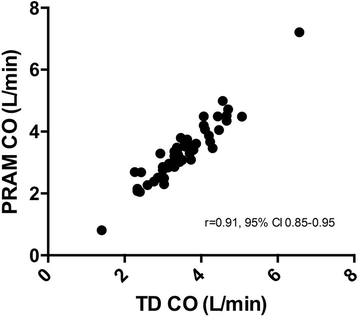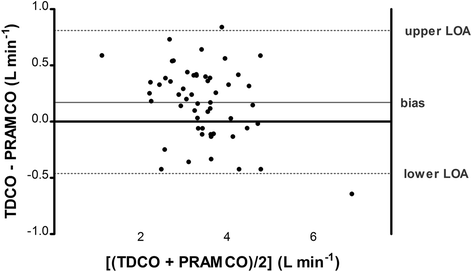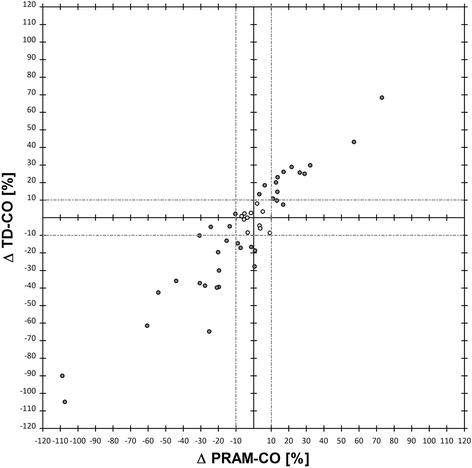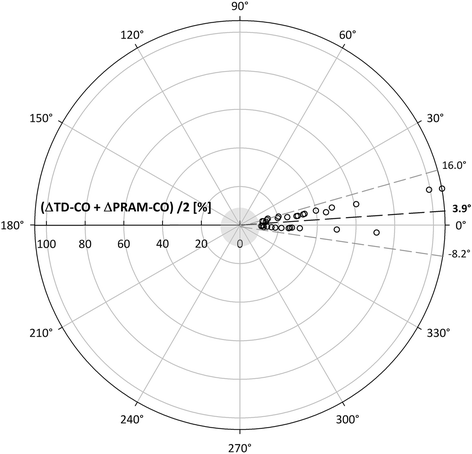A preliminary study evaluating cardiac output measurement using Pressure Recording Analytical Method (PRAM) in anaesthetized dogs
- PMID: 29510691
- PMCID: PMC5840695
- DOI: 10.1186/s12917-018-1392-5
A preliminary study evaluating cardiac output measurement using Pressure Recording Analytical Method (PRAM) in anaesthetized dogs
Abstract
Background: Haemodynamic variations normally occur in anaesthetized animals, in relation to the animal status, administered drugs, sympathetic and parasympathetic tone, fluid therapy and surgical stimulus. The possibility to measure some cardiovascular parameters, such as cardiac output (CO), during anaesthesia would be beneficial for both the anaesthesia management and its outcome. New techniques for the monitoring of CO are aimed at finding methods which are non invasive, accurate and with good trending ability, which can be used in a clinical setting. The aim of this study was to compare the Pressure Recording Analytical Method (PRAM) with the pulmonary artery thermodilution (TD) for the measurement of cardiac output in 6 anaesthetized critically ill dogs.
Results: Fifty-four pairs of CO measurements were obtained with a median (range) of 3.33 L/min (0.81-7.21) for PRAM-CO and 3.48 L/min (1.41-6.56) for TD-CO. The Bland-Altman analysis showed a mean bias of 0.17 L/min with limits of agreement (LoA) of - 0.46 to 0.81 L/min. The percentage error resulted 18.2%. The 4-quadrant plot analysis showed an acceptable concordance (93%) between the 2 methods. The polar plot showed a good trending ability with the mean angular bias of 3.9° and radial LoA ± 12.1°.
Conclusions: The PRAM resulted in good precision, acceptable concordance and good trending ability for the measure of CO in the anaesthetized dog, representing a promising alternative to thermodilution for the measurement of CO. Among all the pulse contour methods available on the market it is the only one that does not require any calibration or adjustment of the measurement. Further studies are required to verify the ability of this method to accurately measure cardiac output even during unstable hemodynamic conditions.
Keywords: Anaesthesia; Cardiac output; Dog; Pressure recording analytical method; Pulse contour.
Conflict of interest statement
Ethics approval and consent to participate
This clinical study has been approved by the Ethical Committee for Clinical Study of the Department of Emergency and Organ Transplantation of the University of Bari, Italy (Prot. n. 48/16-DETO). A written owner consent was obtained before enrolling the dogs in the study.
Consent for publication
Not applicable
Competing interests
The authors declare that they have no competing interests.
Publisher’s Note
Springer Nature remains neutral with regard to jurisdictional claims in published maps and institutional affiliations.
Figures




Similar articles
-
Evaluation of agreement and trending ability between transpulmonary thermodilution and calibrated pulse contour and pulse power cardiac output monitoring methods against pulmonary artery thermodilution in anesthetized dogs.J Vet Emerg Crit Care (San Antonio). 2016 Jul;26(4):531-40. doi: 10.1111/vec.12439. Epub 2016 Jan 11. J Vet Emerg Crit Care (San Antonio). 2016. PMID: 26754858
-
Comparison of thermodilution, lithium dilution, and pulse contour analysis for the measurement of cardiac output in 3 different hemodynamic states in dogs.J Vet Emerg Crit Care (San Antonio). 2014 Sep-Oct;24(5):562-70. doi: 10.1111/vec.12219. Epub 2014 Aug 20. J Vet Emerg Crit Care (San Antonio). 2014. PMID: 25142925
-
Continuous cardiac output monitoring with an uncalibrated pulse contour method in patients supported with mechanical pulsatile assist device.Interact Cardiovasc Thorac Surg. 2011 Jul;13(1):52-6. doi: 10.1510/icvts.2010.264234. Epub 2011 Mar 31. Interact Cardiovasc Thorac Surg. 2011. PMID: 21454314
-
Semi-invasive measurement of cardiac output based on pulse contour: a review and analysis.Can J Anaesth. 2014 May;61(5):452-79. doi: 10.1007/s12630-014-0135-8. Epub 2014 Mar 19. Can J Anaesth. 2014. PMID: 24643474 Review.
-
A critical review of the ability of continuous cardiac output monitors to measure trends in cardiac output.Anesth Analg. 2010 Nov;111(5):1180-92. doi: 10.1213/ANE.0b013e3181f08a5b. Epub 2010 Aug 24. Anesth Analg. 2010. PMID: 20736431 Review.
Cited by
-
Real-Time Monitoring of Cardiac Output Using Non-Invasive Impedance Cardiography in Dogs: A Pilot Study on Heartworm Extraction and Gastric Decompression.Vet Sci. 2025 May 15;12(5):478. doi: 10.3390/vetsci12050478. Vet Sci. 2025. PMID: 40431571 Free PMC article.
-
Intraoperative Assessment of Fluid Responsiveness in Normotensive Dogs under Isoflurane Anaesthesia.Vet Sci. 2021 Feb 11;8(2):26. doi: 10.3390/vetsci8020026. Vet Sci. 2021. PMID: 33670144 Free PMC article.
-
Interventional Heartworm Extraction in Two Dogs: The Clinical Application of Impedance Cardiography.Animals (Basel). 2023 Oct 7;13(19):3127. doi: 10.3390/ani13193127. Animals (Basel). 2023. PMID: 37835733 Free PMC article.
-
Clinical Application of the Fluid Challenge Approach in Goal-Directed Fluid Therapy: What Can We Learn From Human Studies?Front Vet Sci. 2021 Aug 3;8:701377. doi: 10.3389/fvets.2021.701377. eCollection 2021. Front Vet Sci. 2021. PMID: 34414228 Free PMC article. Review.
-
Respiratory and hemodynamic effects of 2 protocols of low-dose infusion of dexmedetomidine in dogs under isoflurane anesthesia.Can J Vet Res. 2020 Apr;84(2):96-107. Can J Vet Res. 2020. PMID: 32255904 Free PMC article.
References
-
- Conti-Patara A, de Araújo Caldeira J, De Mattos-junior E, de Carvalho Hda S, Reinoldes A, Pedron BG, Patara M, Francisco Talib MS, Faustino M, de Oliveira CM, Cortopassi SR. Changes in tissue perfusion parameters in dogs with severe sepsis/septic shock in response to goal-directed hemodynamic optimization at admission to ICU and the relation to outcome. J Vet Emerg Crit Care. 2012;22(4):409–418. doi: 10.1111/j.1476-4431.2012.00769.x. - DOI - PubMed
-
- Peterson NW, Moses L. Oxygen delivery. Compend Contin Educ Vet. 2011;33(1):E5. - PubMed
MeSH terms
LinkOut - more resources
Full Text Sources
Other Literature Sources

